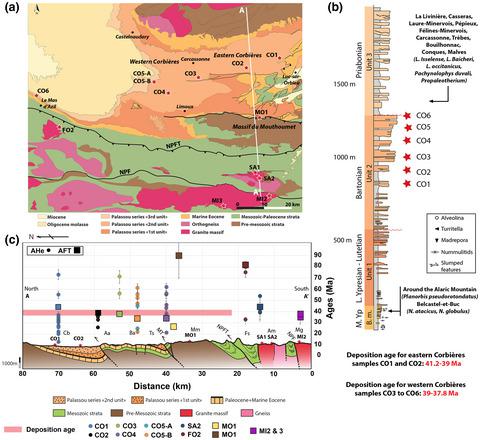当前位置:
X-MOL 学术
›
Basin Res.
›
论文详情
Our official English website, www.x-mol.net, welcomes your feedback! (Note: you will need to create a separate account there.)
Thermal record of the building of an orogen in the retro-foreland basin: Insight from basement and detrital thermochronology in the eastern Pyrenees and the north Pyrenean basin (France)
Basin Research ( IF 3.2 ) Pub Date : 2021-07-15 , DOI: 10.1111/bre.12583 Stéphane M. Al Reda 1 , Jocelyn Barbarand 1 , Cécile Gautheron 1 , Eric Lasseur 2 , Nicolas Loget 3 , Rosella Pinna‐Jamme 1 , Justine Briais 2
Basin Research ( IF 3.2 ) Pub Date : 2021-07-15 , DOI: 10.1111/bre.12583 Stéphane M. Al Reda 1 , Jocelyn Barbarand 1 , Cécile Gautheron 1 , Eric Lasseur 2 , Nicolas Loget 3 , Rosella Pinna‐Jamme 1 , Justine Briais 2
Affiliation

|
An understanding of the evolution of foreland basins improves our knowledge of how mountain belts have grown and helps us to decipher events which may not be preserved in the orogen. The infilling of the north Pyrenean retro-foreland basin (Aquitaine Basin, France) during the main exhumation of the Pyrenees and its corresponding thermal history have not been fully investigated. We applied apatite fission track (AFT) and (U-Th-Sm)/He (AHe) methods coupled with inverse thermal modelling on both the detrital Eocene (47 to 33 Ma) syn-orogenic Palassou conglomerates of the eastern part of the Aquitaine Basin and basement samples from the North Pyrenean Zone and the Axial Zone of the Pyrenees. Apatite crystals were separated from granitic cobbles found in the conglomerates. AFT ages for detrital samples range from 27 ± 2 to 43 ± 4 Ma, and AHe ages from 13 ± 1 to 76 ± 5 Ma. For in situ massifs AFT ages range from 35 ± 2 to 90 ± 17 Ma and AHe ages from 39 ± 2 and 80 ± 5 Ma. AFT ages for detrital samples are close to deposition ages, whereas AHe ages are older and younger than deposition ages and show a partial thermal resetting due to burial. A detailed analysis of the ages obtained and thermal histories derived from modelling shows that ages reflect (a) exhumation from 70 to 55 Ma revealed by a long stay in the partial retention zone (PRZ), (b) a Palaeocene–Eocene cooling in the Pyrenees, (c) a post-depositional episode of moderate heating of the sediments in the basin represented by partially reset young AHe and AFT ages compared to deposition ages and (d) an early to mid-Miocene final exhumation of the basin deposits as evidenced by young AHe ages and geological constrains. These results reflect a common event with the south Pyrenean foreland basin that is characterized by high piedmont aggradation from the late Eocene to the Miocene. The aggradation of sediments is possibly connected with well-known high elevation low relief surfaces in the core of the Pyrenees and followed by a Miocene exhumation event that is already observed on the southern flank. However, the timing of the aggradation and exhumation events could be different between the north and the south. Erosion occurred most probably during the early to mid-Miocene in the north and during the late Miocene–early Pliocene in the south.
中文翻译:

后前陆盆地造山带形成的热记录:从东比利牛斯山脉和北比利牛斯盆地(法国)的基底和碎屑热年代学洞察
对前陆盆地演化的了解提高了我们对山带如何生长的了解,并帮助我们破译了可能无法保存在造山带中的事件。北比利牛斯山脉后前陆盆地(法国阿基坦盆地)在比利牛斯山脉主要开采过程中的充填及其相应的热历史尚未得到充分研究。我们应用磷灰石裂变径迹 (AFT) 和 (U-Th-Sm)/He (AHe) 方法以及逆热模拟对阿基坦东部的碎屑始新世(47 至 33 Ma)同造山地帕拉苏砾岩来自北比利牛斯山脉和比利牛斯山脉轴向区的盆地和地下室样本。磷灰石晶体是从在砾岩中发现的花岗岩鹅卵石中分离出来的。碎屑样品的 AFT 年龄范围从 27 ± 2 到 43 ± 4 Ma,和 AHe 年龄从 13 ± 1 到 76 ± 5 Ma。对于原位地块,AFT 年龄范围为 35 ± 2 至 90 ± 17 Ma,AHe 年龄范围为 39 ± 2 和 80 ± 5 Ma。碎屑样品的 AFT 年龄接近沉积年龄,而 AHe 年龄比沉积年龄更老和更年轻,并且由于埋藏而显示出部分热复位。对获得的年龄和从建模得出的热史的详细分析表明,年龄反映了 (a) 70 至 55 Ma 的剥露,这是由长期停留在部分保留带 (PRZ) 中揭示的,(b) 古新世 - 始新世在比利牛斯山脉,(c) 盆地沉积物适度加热的沉积后事件,与沉积时代相比,以部分重置的年轻 AHe 和 AFT 时代为代表,以及 (d) 早中新世盆地沉积物的最终剥露,如所证明的受年轻的 AHe 年龄和地质限制。这些结果反映了南比利牛斯前陆盆地的一个共同事件,其特征是从晚始新世到中新世的高山麓加积。沉积物的聚集可能与著名的比利牛斯山脉核心的高海拔低地势表面有关,随后发生了已经在南翼观察到的中新世剥露事件。然而,北部和南部之间的聚集和挖掘事件的时间可能不同。侵蚀最有可能发生在北部的早中新世和南部的中新世晚期-上新世早期。沉积物的聚集可能与比利牛斯山脉核心的众所周知的高海拔低地势表面有关,随后发生了已经在南翼观察到的中新世剥露事件。然而,北部和南部之间的聚集和挖掘事件的时间可能不同。侵蚀最有可能发生在北部的早中新世和南部的中新世晚期-上新世早期。沉积物的聚集可能与著名的比利牛斯山脉核心的高海拔低地势表面有关,随后发生了已经在南翼观察到的中新世剥露事件。然而,北部和南部之间的聚集和挖掘事件的时间可能不同。侵蚀最有可能发生在北部的早中新世和南部的中新世晚期-上新世早期。
更新日期:2021-09-03
中文翻译:

后前陆盆地造山带形成的热记录:从东比利牛斯山脉和北比利牛斯盆地(法国)的基底和碎屑热年代学洞察
对前陆盆地演化的了解提高了我们对山带如何生长的了解,并帮助我们破译了可能无法保存在造山带中的事件。北比利牛斯山脉后前陆盆地(法国阿基坦盆地)在比利牛斯山脉主要开采过程中的充填及其相应的热历史尚未得到充分研究。我们应用磷灰石裂变径迹 (AFT) 和 (U-Th-Sm)/He (AHe) 方法以及逆热模拟对阿基坦东部的碎屑始新世(47 至 33 Ma)同造山地帕拉苏砾岩来自北比利牛斯山脉和比利牛斯山脉轴向区的盆地和地下室样本。磷灰石晶体是从在砾岩中发现的花岗岩鹅卵石中分离出来的。碎屑样品的 AFT 年龄范围从 27 ± 2 到 43 ± 4 Ma,和 AHe 年龄从 13 ± 1 到 76 ± 5 Ma。对于原位地块,AFT 年龄范围为 35 ± 2 至 90 ± 17 Ma,AHe 年龄范围为 39 ± 2 和 80 ± 5 Ma。碎屑样品的 AFT 年龄接近沉积年龄,而 AHe 年龄比沉积年龄更老和更年轻,并且由于埋藏而显示出部分热复位。对获得的年龄和从建模得出的热史的详细分析表明,年龄反映了 (a) 70 至 55 Ma 的剥露,这是由长期停留在部分保留带 (PRZ) 中揭示的,(b) 古新世 - 始新世在比利牛斯山脉,(c) 盆地沉积物适度加热的沉积后事件,与沉积时代相比,以部分重置的年轻 AHe 和 AFT 时代为代表,以及 (d) 早中新世盆地沉积物的最终剥露,如所证明的受年轻的 AHe 年龄和地质限制。这些结果反映了南比利牛斯前陆盆地的一个共同事件,其特征是从晚始新世到中新世的高山麓加积。沉积物的聚集可能与著名的比利牛斯山脉核心的高海拔低地势表面有关,随后发生了已经在南翼观察到的中新世剥露事件。然而,北部和南部之间的聚集和挖掘事件的时间可能不同。侵蚀最有可能发生在北部的早中新世和南部的中新世晚期-上新世早期。沉积物的聚集可能与比利牛斯山脉核心的众所周知的高海拔低地势表面有关,随后发生了已经在南翼观察到的中新世剥露事件。然而,北部和南部之间的聚集和挖掘事件的时间可能不同。侵蚀最有可能发生在北部的早中新世和南部的中新世晚期-上新世早期。沉积物的聚集可能与著名的比利牛斯山脉核心的高海拔低地势表面有关,随后发生了已经在南翼观察到的中新世剥露事件。然而,北部和南部之间的聚集和挖掘事件的时间可能不同。侵蚀最有可能发生在北部的早中新世和南部的中新世晚期-上新世早期。


























 京公网安备 11010802027423号
京公网安备 11010802027423号